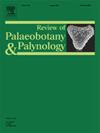评价栎花粉作为地中海中部过去UV-B水平的宝贵档案:来自比较红外光谱分析的见解
IF 1.7
3区 地球科学
Q2 PALEONTOLOGY
引用次数: 0
摘要
花粉和孢子外皮中紫外线吸收化合物(UACs)的相对丰度随暴露于紫外线B (UV-B)辐射的时间延长而增加。这种关系已经通过透射傅里叶变换红外微光谱(transmission micro-FTIR)进行了广泛的研究,主要是在石松孢子和空气中的松花粉中。然而,传统的透射显微ftir方法容易受到红外光的散射和干扰,导致光谱变形,再现性降低。此外,像松属植物一样的双花花粉可以长距离传播,可能无法准确反映当地的UV-B水平。本研究比较了透射和衰减全反射(ATR)微傅里叶变换红外(ftir)方法的可重复性,并研究了栎花粉作为地中海中部地区潜在的UV-B代用物的可能性。对新鲜(原位)、捕获(苔藓中)和化石(来自全新世沉积物)花粉颗粒进行了不同的化学处理,然后对单个和簇状花粉颗粒的大分子组成进行了表征。结果表明,ATR微傅里叶红外比透射微傅里叶红外产生的可重复性数据要高得多,表明该方法适用于系统的化学孢粉学研究。在现代和化石样品中,栓皮栎花粉始终显示出与uac相关的吸收带,盐酸、氢氟酸和氢氧化钠处理不会显著改变这些特征。对新鲜花粉和捕获花粉的比较进一步支持了这些发现。这些结果表明,现代和化石栎皮中的相对UAC浓度可能反映了累积的UV-B剂量,确定栎花粉是重建地中海中部过去UV-B水平的有价值的当地UV-B代理。本文章由计算机程序翻译,如有差异,请以英文原文为准。
Evaluating Quercus pollen as a valuable archive of past UV-B levels in the Central Mediterranean: Insights from comparative infrared spectroscopy analyses
The relative abundance of ultraviolet-absorbing compounds (UACs) in pollen and spore exine increases with prolonged and higher exposure to ultraviolet B (UV-B) radiation. This relationship has been extensively studied via transmission Fourier-transform infrared microspectroscopy (transmission micro-FTIR), primarily in Lycopodium spores and airborne Pinus pollen. However, traditional transmission micro-FTIR methods are prone to infrared light scattering and interference, resulting in spectral deformations and reduced reproducibility. Additionally, bisaccate pollen, like Pinus, can travel long distances and may not accurately reflect local UV-B levels. This study compares transmission and attenuated total reflection (ATR) micro-FTIR methods to assess their reproducibility and investigates Quercus pollen as a potential local UV-B proxy in the Central Mediterranean. Samples containing fresh (in situ), trapped (in mosses), and fossilized (from Holocene sediments) pollen grains were subjected to various chemical treatments, after which the macromolecular composition of single and clustered grains was characterized. Results show that ATR micro-FTIR yields significantly more reproducible data than transmission micro-FTIR, demonstrating the suitability of this method for systematic chemo-palynological studies. Quercus ilex pollen consistently display UAC-related absorption bands across modern and fossil samples, and treatment with hydrochloric acid, hydrofluoric acid, and sodium hydroxide does not significantly alter these signatures. A comparison with fresh and trapped Q. cerris and Q. pubescens pollen further supports these findings. These results suggest that relative UAC concentrations in modern and fossil Quercus exine likely reflect accumulated UV-B dosage, pinpointing Quercus pollen as a valuable local UV-B proxy for reconstructing past UV-B levels in the Central Mediterranean.
求助全文
通过发布文献求助,成功后即可免费获取论文全文。
去求助
来源期刊
CiteScore
3.50
自引率
21.10%
发文量
149
审稿时长
6 months
期刊介绍:
The Review of Palaeobotany and Palynology is an international journal for articles in all fields of palaeobotany and palynology dealing with all groups, ranging from marine palynomorphs to higher land plants. Original contributions and comprehensive review papers should appeal to an international audience. Typical topics include but are not restricted to systematics, evolution, palaeobiology, palaeoecology, biostratigraphy, biochronology, palaeoclimatology, paleogeography, taphonomy, palaeoenvironmental reconstructions, vegetation history, and practical applications of palaeobotany and palynology, e.g. in coal and petroleum geology and archaeology. The journal especially encourages the publication of articles in which palaeobotany and palynology are applied for solving fundamental geological and biological problems as well as innovative and interdisciplinary approaches.

 求助内容:
求助内容: 应助结果提醒方式:
应助结果提醒方式:


